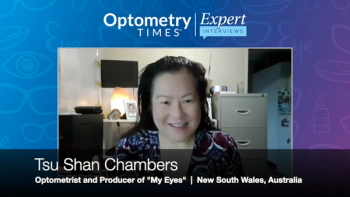
Understanding, treating ocular and visual complications in Parkinson's disease
Jacqueline Theis, OD, FAAO, gives key takeaways from her AAOpt 2022 meeting presentation, "Ocular and visual complications of Parkinson's disease."
Jacqueline Theis, OD, FAAO, shares highlights from her discussion titled, "Ocular and visual complications of Parkinson's disease," which she presented during the 2022 American Academy of Optometry meeting held in San Diego.
Editor's note: This transcript has been edited for clarity.
Hi, I'm Jacqueline Theis. And I spoke on ocular and visual complications in Parkinson's disease.
So this is one of my favorite lectures to give, because as optometrists, we really can give a lot to our patients who have Parkinson's disease from so many different aspects.
From early onset Parkinson's disease, it can actually be very difficult for neurologists to diagnose it. And there's a lot of presentations where the patient will actually come to your office. So early presentations can be things like dry eye, it's a little bit a typical of a dry eye, because the dry eye is actually stemming from decreased lacrimal gland secretion, as well as neurologic problems with blink rate.
So Parkinson's patients tend to have a reduced blink rate and patients with progressive supranuclear palsy (PSP) have an even slower blink rate. So on average, patients blink maybe 14 to 15 times a minute. And someone with Parkinson's or PSP may only blink three to four times a minute. So if you have a patient with dry eye and a slow blink rate, they may actually have Parkinson's disease, and they might be presenting initially in your office before they even have a diagnosis.
So if there's one takeaway I can say for my lecture, it's do blink rate. Literally just count blinks while you're behind the slit lamp and make sure the patient doesn't have a neurologic reason for having their dry eye.
The other things that I talked about in my lecture also went into obviously the incredible ocular motor dysfunction that can happen in patients who had Parkinson's, including convergence insufficiency, but also micro-saccadic and saccadic dysfunction, trouble with fixation, smooth pursuits. And then I also discussed a lot about prism ramifications, but you can also do pencil pushups for these patients as well.
And then we went to the back of the eye as well. So retinal complications can occur with Parkinson's disease because they have reduced thinning from dopaminergic dysfunction in the retinal layer, in which case patients can have reduced contrast sensitivity. And they can also get thinning of the retina, which can sometimes mimic glaucoma. And patients with Parkinson's can also have glaucoma as well.
So it's the lecture in and of itself was obviously very broad, because Parkinson's can impact the eye, how the eyes move, and then the ocular health of the eye as well.
The other thing that we need to make sure that we ask our patients with Parkinson's disease is if they have any symptoms of visual hallucinations. A lot of patients who have Parkinson's disease will suffer from visual hallucinations but never actually tell the provider.
And this is important to discuss with your patients, kind of like when we have patients with Charles Benay syndrome, because number one validating that their symptoms are real, and that they're coming from the Parkinson's and not that they're losing their mind is really helpful for patients. It's also important to if you look in statistics, patients who have visual hallucinations and Parkinson's are more likely to need caregiving. So if you have a patient who's living by themselves a visual hallucinations, they're usually in a very end-stage of their disease, and they may be more likely inclined to needing someone to live with them, get a caretaker in their home, or actually have them go to a home to be taken care of.
The eyes are really important in patients who have Parkinson's for many reasons, but one of the big reasons that we have to think about is that as patients lose their mobility from Parkinson's due to the motor development, whether they're unable to move their neck or unable to move their body, they're going to be more reliant on their visual system to scan where they're going. And so we need to make sure that we're correcting them optically, that we're putting them in good single vision distance glasses, so that their progressive modality isn't getting in the way since they can't actually move their neck sometimes to be able to function that modality. So I love this lecture. I'm sad you missed it, but hopefully you'll get to see it some other time.
Newsletter
Want more insights like this? Subscribe to Optometry Times and get clinical pearls and practice tips delivered straight to your inbox.



















































.png)


